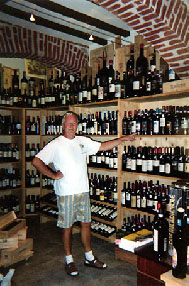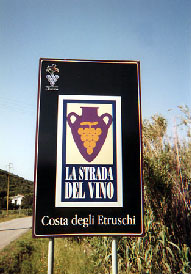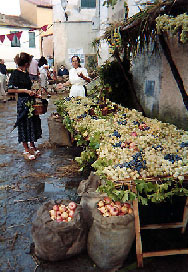Isola d'Elba - Confessions of a wine tourist
by Caesar Glebbeek
Isola d’Elba, Tuscany. My love-affair with Elba started back in May 1999 when I first saw its contours popping up in the distance during the 1-hour ferry trip from Piombino to Portoferraio. If you like to do a mix of things while on holiday, Elba is a lovely place to go to. It offers superb and safe swimming in glorious blue waters, countless beautiful beaches (sand, pebbles, and rocks), wonderful hikes, good restaurants, nice local wines, a friendly population (give or take a grumpy ATL bus driver), and plenty of things to do and see.
Most of the island is very panoramic, helped by the fact that there are no eyesores to be found (strict building regulations are enforced). And, of course, fine weather - from April to October. The main drawbacks are annoying tour busses driving up and down Elba’s winding and narrow roads, and far too many visiting Germans. Don’t even think about visiting Elba during July and August when the entire small island (just 28km long and 19km wide) turns into one nasty gridlock nightmare, while the rest of the tourist hordes fight for space on the beach.
Okay, onto the vinos! Elba’s wine culture dates back to ancient times. At it’s peak in 1830, the vines numbered over 32 million. Following several disasters (mildew; vine louse), the production dropped dramatically, but in 1878 it recovered, when it produced about 20 times more as the current production. After that it went down again. During the ‘60s Elba produced nothing but mediocre plonk (all drank by the tourists), and it is only in recent years that wines from the island have gone up in quality. At present, about 125 hectares are turned into the following 7 DOC vinos: Elba Bianco, Elba Ansonica, Elba Rosso, Elba Rosso Riserva, Elba Moscato, Elba Aleatico, and Elba Ansonica Passito.
The three main producers at the moment on Elba are: Acquabona, Cecilia, and La Chiusa. The harvest of grapes on Elba usually already takes place in mid August. Acquabona produces a top-class Aleatico and a decent Bianco, La Chiusa offers pleasant whites, while Cecilia puts out a fine Moscato and comes up trumps with a fantastic Rosso Riserva. The latter is made from 100% Sangiovese grapes (Elba producers may mix in up to 40% of other grapes) - you will be hard pushed to find a better Sangiovese anywhere in Italy for so little money. In May 2001 the courteous owner of Cecilia, Giuseppe Camerini, had some time on his vino-hands and showed me around on his small estate HQ near La Pila, followed by a tasting session of all of his products. Cecilia (since 1990) also sells direct to the public (a box with 6 bottles of Rosso Riserva 1998 for just 99,000 Lires; in the enoteca’s you can expect to pay around 24,000 per bottle). When I left the Cecilia estate Mr. Camerini said, “You should taste and compare our Rosso Riserva with the one produced by Acquabona...” A remark of an objective professional, I thought. Thus a few days later I tried the Rosso Riserva 1997 from Acquabona, but it was a huge disappointment. It lacked everything the Riserva from Cecilia had in abundance: a wonderful nose, a distinctive Sangiovese taste, and lots of character. The vino-bible ‘Italian Wines 2001’ (put out by the Slow Food Arcigola Editore) commented on the Riserva 1997 from Acquabona as having “a washed-out colour.” Prices for bottles can vary enormously on Elba, so it certainly pays to shop around. Two examples here. A bottle of Elba Aleatico (Acquabona) should cost around Lire 43,000, but venture into the “wrong” shop a few meters further down the road and they may want 53,000 instead; in Procchio I picked up a Chianti Classico Riserva Ducale 1988 (Ruffino) for the bargain price of Lire 37,500, while in Marciana Marina I saw another Chianti Classico Riserva Ducale (Ruffino) of a lesser vintage year for a staggering Lire 210,000. “Pricing error?” I asked the shop owner. “No!” was the response. In general, La Casa Del Vino in Procchio offers the biggest vino selection with the lowest price tags on Elba, while Piero Bernotti, the friendly owner of La Boutique dei Vino (also in Procchio) has some interesting non-Elba bottles on the shelves. Piero suggested a Bolgheri Rosso/Alfeo 1998 to me, which turned out to be fantastic. You will find Enoteca’s in just about any village on Elba.
- Elba’s most famous ‘visitor’: Napoleon (1814).
- Most picturesque village: Capoliveri.
- Food tips: Ristorante Publius, Poggio (lunch and diner; extensive wine list); Ristorante la Fenicia, Marciana Marina (lunch and diner; fish specialities); Osteria del Chirlo Grigio, La Pila (diner only).
- Best Enoteca’s: La Casa Del Vino, Procchio; Il Cantione SNC, Marciana Marina; La Boutique dei Vino, Procchio.
- Wine Estate Cecilia, La Pila. Visiting hours and direct sales: 09:00 to 12:00 and 15:00 to 19:00, except Sundays and holidays. Meeting with the owner strictly by appointment only.
- Best boat excursion with swimming stops: m/b Primavera with Capitan Piero. “Spaghetti del marinaio” lunch included. Departs from Marina di Campo at 09:00 and returns at approximately 15:00. Around 50,000 Lires (more in the high season months).
- Most challenging walk: from Pomonte (32 meter) to Monte Cenno (592), to Colle della Grottaccia (647 meter), to Le Filicaie (870), to Monte Capanne (1,018 or 1,019 meter, depending on which map you check!), and then descending to Monte Maolo (749), to Monte Perone (630), to Monte Castello (227), to Procchio (10 meter). Tracks: 9, 31, 8, 00, 5, 18. This hike will take all day to complete, so start no later as 09:30 in Pomonte. Note that the 00 section from Le Filicaie to the summit of Monte Capanne is for experienced walkers only (if you are not up for this steep rocky climb, take track 5 followed by track 1 instead of 00 to get to the top of Elba). NB For the less energetic, there’s a “cable car” just before Marciana which goes to the summit of Monte Capanne (in true Italian tradition, it does not run during lunch hours!).
- Other suggested walks: track 4; track 33 down to Acquabona; track 48 (wonderful sea views); track 14 (interesting rocks); track 63 (some parts are badly marked, or not marked at all). If you are lucky during hikes you may spot deer, mountain goats, and wild boars. But be aware of snakes (especially during hot days), most jump harmlessly away but I bumped into a (poisonous) Aspis Viper on a mountain track. Luckily it was asleep! * Other sights of interest: Volterraio (track 55); Madonna del Monte (start from Marciana and take the paved road flanked by 14 cross stations); Torre di San Giovanni; and Villa Napoleonica di San Martino (Napoleon’s summer residence). The Eastern part of the island has many of the best walks, is the least populated, has some of the most spectacular coastal scenery, and offers two great beaches (Fetofaia/sand; S. Andrea/rocks). If you holiday on Elba without your own transport (with a bit of planning it is possible to get to almost all places by local ATL bus) the best central area to stay would be in/near Procchio.











